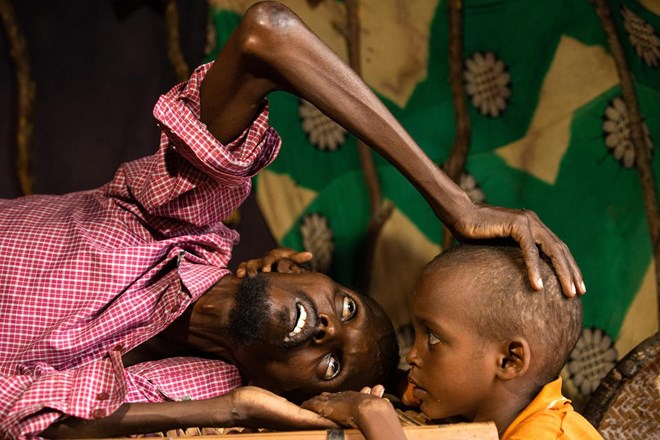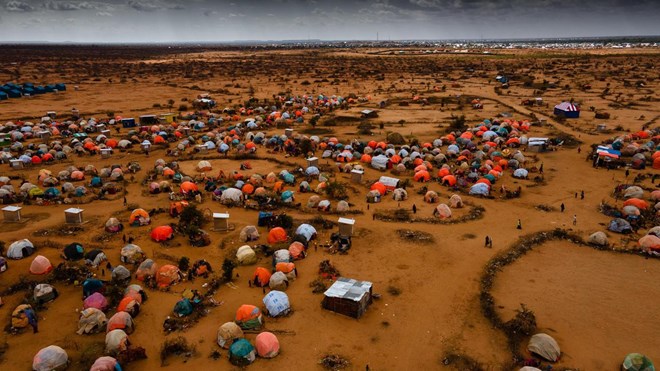
Monday October 31, 2022
By Conor Feehan
Camps of displaced people are ravaged by disease and death, with fears another dry ‘rainy season’ will deepen crisis

Abdirashid Muktar Nishow (5) looks over his father Muktar (40), who is suffering from severe malnourishment, in the Unicef-supported Ladan internally displaced persons camp in Dolow, Somalia. Photo: Mark Condren
Somalia is on the brink of famine disaster, with one child now admitted to a health facility every minute of every day for treatment of severe malnutrition.
Four rainy seasons have failed to materialise, and the UN has warned that 350,000 children could die this year.
Drought has killed livestock and the crops they live on. The situation is so stark it is now expected famine will be declared by the UN before Christmas.
The drought has forced one million people, mainly mothers and children, to leave their homes and small subsistence farms. They walk vast distances to towns where they hope help will be available, begging for food and water on the way.
Camps of internally displaced Somalians are now growing on the outskirts of towns, and the Irish Independent has seen first-hand how the downward spiral of hunger, thirst, malnutrition and disease is leading to children dying in the arms of their mothers.
In stabilisation centres at clinics and hospitals around the country, organisations like Unicef are supporting the assessment and treatment of malnourished babies and children.
Some children who are two-years-old barely weigh more than a healthy five-month-old. And five-month-old babies sometimes weigh the same as a healthy newborn.
It is a full-blown crisis that is worsening by the day. The latest rates from August show 44,000 children were admitted for treatment of severe acute malnutrition. That is one child per minute.
“The children behind this staggering, appalling statistic are those who actually make it to a treatment centre,” Unicef spokesman James Elder said.
“In a country where access to the most vulnerable is continually hampered by terrorism and threats to aid workers, we fear many thousands more children are not reaching the support they need.”
There are usually two rainy seasons in Somalia each year. The drought has been going on for three years.
It is feared that a fifth rainy-season drought would tip Somalia and the rest of the Horn of Africa into a deeper crisis.
That dreadful prospect comes in the wake of Covid, as well as a desert locust infestation which destroyed the meagre crops that were struggling to rise from the parched earth.
The one million Somalians displaced from their homes and farms since January comes on top of the two million displaced from a combination of drought in 2017 and famine in 2011.
Speaking at an internally displaced persons (IDP) camp, Unicef’s executive director in Ireland, Peter Power, said the charity has 300 humanitarian aid specialists on the ground in Somalia.
“We’ve been dealing with emergencies for 70 years, so we have huge capacity to be able to respond,” he said. “The difference with this crisis, I would say, is that this is a climate-change induced drought, which has led to a huge humanitarian crisis.
“We’re working across a number of different areas. We’re the biggest supplier of nutrition for children here, and we’re providing medical and non-medical health support for children, in the camps, and in health facilities.
“We’re also involved in child protection, which is protecting children who have often had to walk 50km, sometimes 100km, and are very, very vulnerable. In these camps, conditions are very poor.
“We’re providing water, sanitation and hygiene, as well as medical assistance.”
The Ladan internally displaced persons camp in Dolow, Somalia
The camp at Ladan, outside Dolow – a town with dirt roads where donkey and cart are the main form of transport – is like hundreds of others in Somalia.
The camp’s population is 20,000 and growing daily. New arrivals add to the growing number of makeshift tents, which are constructed from branches. Pieces of frayed fabric and plastic sheeting are stretched out over them.
Each tent is erected in a random location, with hardly any space to the next one.
The average population of each tent is six people. The mothers and older children cook whatever food they can get on small open fires after begging or labouring in the nearest town.
If a nursing mother cannot find food for herself, she is at risk of being unable to breastfeed her baby as her own health deteriorates. In these circumstances, the cycle of malnutrition, disease, illness and death can be
swift.
When deaths occur on the camps, the bodies of babies and young children are often buried in the ground within the camp, with nothing to mark their final resting place. If it wasn’t for the work of aid agencies such as Unicef and others like it, the plight of those in the camps would be even worse.
They have gone into the camps and drilled wells to pump water from deep in the ground.
This water then has to be treated before it can be consumed, and piped to water stations around the site. But demand for the scarce water is high, and barely a trickle falls from the taps.
Before arriving at a camp, most people use the open ground as a toilet.
In an effort to lessen the outbreak of diseases, aid agencies have supported the construction of dozens of communal toilet systems at IDP camps.
The camps are mainly populated by women and children. In a country known for being one of the toughest places for females to live, this brings its own risks.
Around 82pc of internally displaced persons in drought-affected communities in Somalia are women and children.
Things are bad here and every sign indicates that they are going to get worse.
“Without greater action and investment, we are facing the death of children on a scale not seen in half a century,” said Unicef’s James Elder.